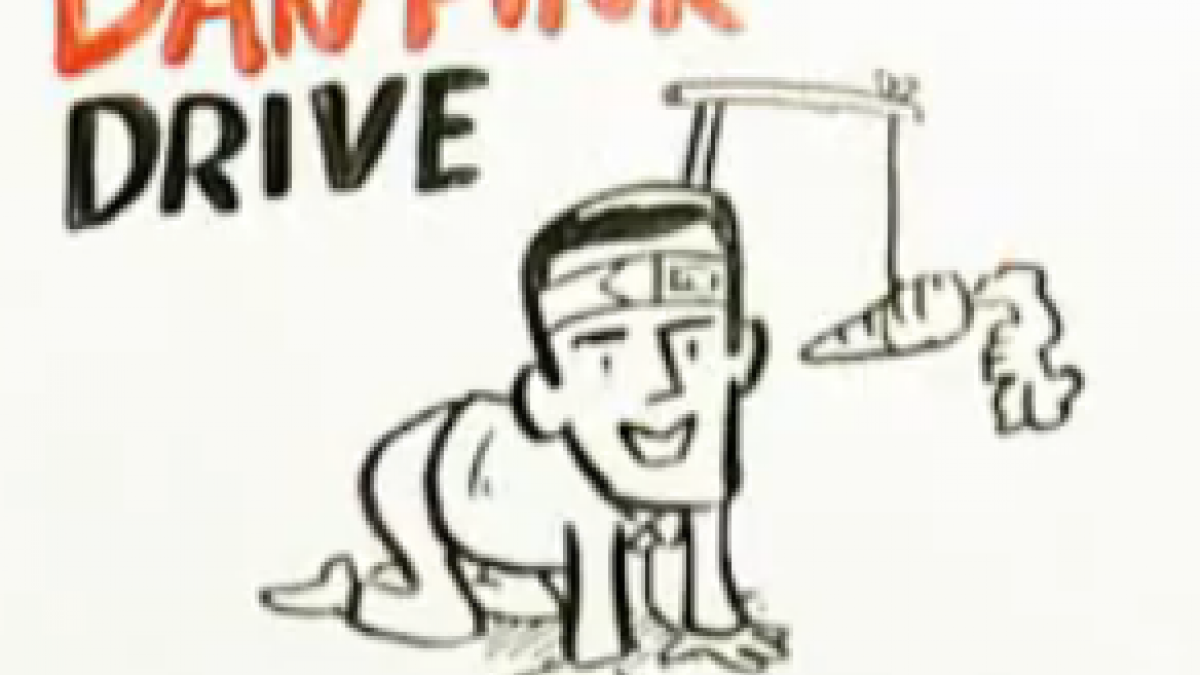
Book Review - Drive: The Surprising Truth About What Motivates Us
The book <em>Drive: The Surprising Truth About What Motivates Us</em> is about the <a href="http://www.ted.com/talks/dan_pink_on_motivation.html" target="blank">importance of intrinsic motivation</a>. The foundation of the book is that there are three levels of human motivation:
<ol>
<li>Basic needs – survival, food, sex, etc.</li>
<li>External rewards and punishment</li>
<li>Internal interest and purpose</li>
</ol>
The basic premise is that starting with the industrial revolution most business management philosophy, referred to as management 2.0, revolves around the second motivator. Management 2.0 uses a system of extrinsic "carrots and sticks" motivators to reward good behavior and punish bad.
Daniel Pink proposes there is a better, stronger way of motivating he calls management 3.0. This philosophy is derived by studies, mostly academic, that point towards the intrinsic drive humans have to do things that interest them. Furthermore Pink proposes that most times extrinsic motivators reduce people’s intrinsic drive, thus the two management philosophies are at odds with each other.
One of the more compelling concepts of the book is the shift in the type of work Americans engage in since the advent of management 2.0 more than a century ago. The book divides work into algorithmic tasks where workers must do the same repetitive task over and over again and heuristic tasks where workers must innovate, coming up with new solutions to new problems. At the beginning of the industrial revolution work was dominated by boring algorithmic tasks. People avoid this type of work therefore they must be compensated to do it and incentivized by money or other extrinsic motivators to assure productivity and compliance.
Now much of the algorithmic tasks have been automated or outsourced. Americans do more heuristic work. Heuristic work is more interesting, and personally satisfying. Thus the conclusion of <em>Drive</em> is that heuristic work is better encouraged by intrinsic motivators.
<h3>My review</h3>
When I started this book I was very excited. I am a big believer in intrinsic motivation and very interested in how to get more of it into our work. The book is very well reviewed on Amazon, thus I was hoping for some great nuggets of wisdom.
Ultimately my problem with this book is the same problem I had with <em>To Kill a Mockingbird</em>. It gave me <a href=”http://en.wikipedia.org/wiki/To_Kill_a_Mockingbird_in_popular_culture#Te...” target="blank">no useful advice on killing mockingbirds</a>.
The book provides some general recommendations like:
<ul>
<li>Let your staff spend 20% of their time working on what they want to, a la <a href="http://www.scottberkun.com/blog/2008/thoughts-on-googles-20-time/" target="blank">Google</a></li>
<li>Let your staff have complete autonomy over their tasks, time, team, ect. a la <a href="http://gorowe.com" target="blank">ROWE</a></li>
<li>Get rid of billable hours</li>
<li>Pay your staff more than the industry average</li>
</ul>
<h3>Issue #1 - The other side of the equation</h3>
By now you likely see the basic problem with these recommendations - the other side of the equation. Ultimately an economy exists because person A and person B both have something the other wants, so they exchange goods. In the agency world, the client has money. The agency has the ability to produce a website, creative, marketing or similar good. Clients pay agencies to do what is valuable to them.
I have experimented with the 20% time concept, although more in the 10% range. Funny what happens, if you spend 10% of your time doing things that are of interest to staff, clients don’t want to pay you for that, your billables go down and now you can't afford to pay employees even industry standards, much less above industry standards.
The book praises several motivation 3.0 leaders such as Google. What the book doesn’t tell you is that only engineers and only some engineers at Google get to spend 20% of their time on their own projects. Also there are many reports that this practice is more like 120% time, that there is a significant amount of overtime work on regular projects thus the 20% is in addition to a full workload.
I actually greatly admire this about Google, but Google is Google. The rest of us do not have a near monopolistic technology that generates googles of money giving us the convenience of allowing people to ad hoc innovate. Additionally, Google is in the innovation business. That is their main product and they spend a high percentage of their time innovating as a numbers game. While I have tried to convince several clients to retain us in an innovation driven relationship, most opt for one where we work on things the client knows needs to get done and maybe we get to spend 10% or so of our time pushing the innovation envelope.
<h3>Issue #2 - It's about team</h3>
One of the reoccurring themes of <em>Drive</em> is the importance of individual autonomy. Letting people do things they way they prefer without group boundaries. In particular they praise Best Buy's Result Oriented Work Environment Model (ROWE), where people get to pick their own hours, work place, tasks, etc.
I do agree that business need to focus on results more than how the work is done. The problem I have with the way it is presented in <em>Drive</em>, the emphasis is on autonomous individuals. In the agency world ROWE is already common place, it is called freelancing.
However, freelancing can only get you so far. The goal of an agency should be to bring a group of people together in a way where the whole is greater than the sum of the parts. This is a part of the brilliance of agile processes. It gets individuals thinking like a team. Agile does provide a lot of autonomy, but it is around team goals, team tasks and team commitments, not necessarily individual's. Agile provides a framework for individuals to self-organize around the goals of the team, in this manner the output is the result of synergistic group thinking rather that a collection of unsynchronized individual efforts.
One of the keys for agile is time for the group to sync; sprint planning, daily standups, sprint reviews and retros, paired programming, etc. ROWE as it is described in <em>Drive</em> would create significant impediments to the agile team actually functioning as a team.
<h3>Issue #3 - Too much of a good thing</h3>
The book refers to some researcher's observations that extrinsic motivators have a drug-like effect that leads to diminishing results. The concept is if you use extrinsic motivation, such as a cash bonus for employees achieving a specific goal, there may be an increase in goals achieved at first. However, over time the bonus will lose its effectiveness and may even cause a reduction in the desired behavior.
I have no doubt that this is effect occurs in some situations. But I have observed the exact same phenomenon with intrinsic motivators and generally the effect is more severe. While not true for the majority of people, but definitely enough to be statistically significant, I have seen intrinsic motivation has spark a sort of intrinsic driven downward spiral.
It happens like this...
There are initiatives we undertake at LevelTen more for their intrinsic value than the business value. Sometimes we chalk these projects up to experimentation, exploration or just fun. I'll give these intrinsically valuable projects to people that find them fun and interesting. However, sometimes, even more often than I would like to remember, the intended consequence has the opposite effect. Sometimes the staff member loses all interest in their regular work, e.g. the stuff that keeps the lights on and pays their salary, and is only inspired by projects they find intrinsically valuable.
More than a few times talented employees have left LevelTen after being given intrinsically rewarding tasks to "follow their heart" and find a job that inspires them and offers even more intrinsic motivation. Many find work high in both intrinsic value and financial compensation are hard to come by.
<h3>Conclusion</h3>
I have an affinity for iconoclastic business philosophies. There are parts of <em>Drive</em> that I do like. I do agree that doing work that is intrinsically motivating is important. I also agree that the ability to innovate is becoming increasingly important and giving people autonomy and inspiration is vital for creating an innovative environment. However the lack of the books practical advice of how to infuse intrinsic valued tasks with those that actually provide financial stability make it all the more maddening. You tell me it is important, but not how to actually make it happen in a real world company.
I also felt the book was too one sided. Intrinsic motivation is not the ultimate panacea of awesomeness and not all extrinsic motivation is the work of the devil. Much of the evidence in <em>Drive</em> is academic and does not translate well into a real world work environment. Sure Tom Sawyer got his buddies to do the work of whitewashing the fence by making look fun. But he didn’t get them to do it 40 hours a week year in and year out.
In fairness, Daniel Pink hints at these short failings. He even poses the question of if the book is too Utopian. Mr. Pink at the end says his goal is to get you to think more about intrinsic motivation and discuss it with your colleagues. As you can tell by the length of this post, there he succeeded.
On a side note, I can't believe I got to the end of the book and this blog post before I realized the author is <a href="http://www.youtube.com/watch?v=4XBZO8JcClM&feature=related" target="blank">Mr. Pink</a>. Now I really hope Mr. Pink writes another book so I can write a review filled with Reservoir Dogs quotes.

